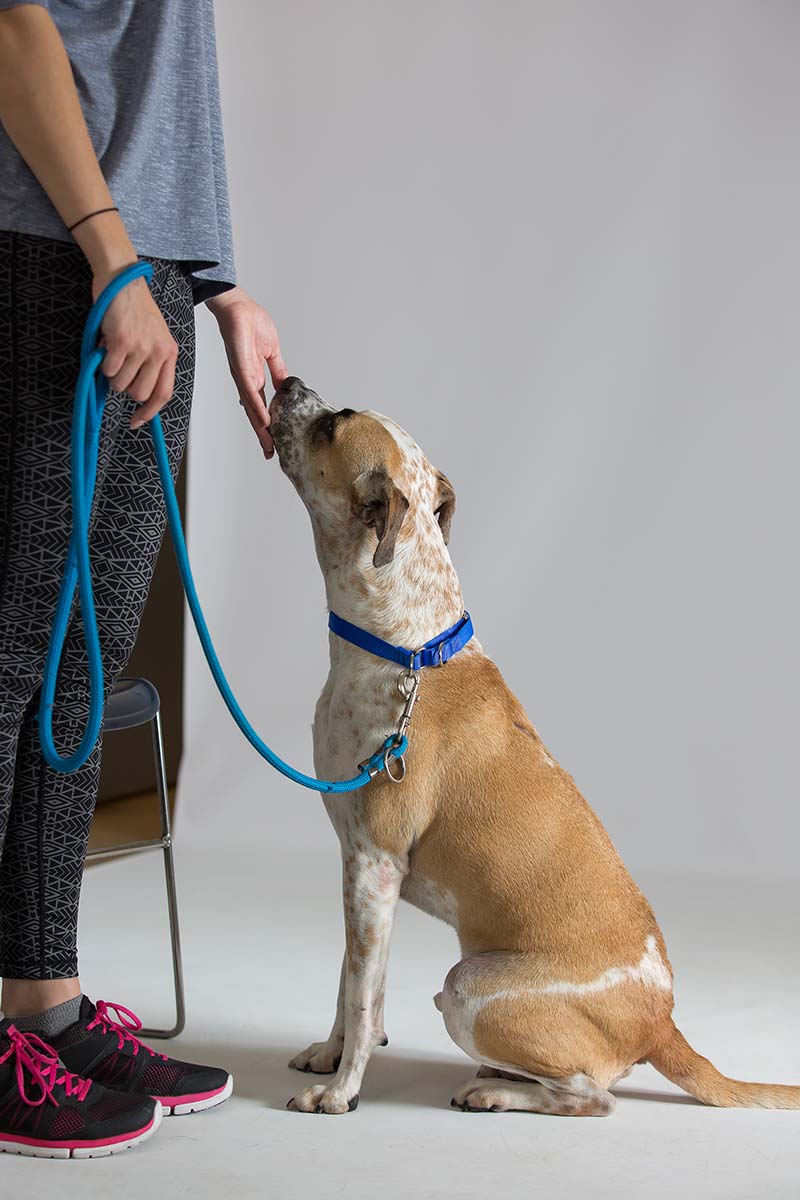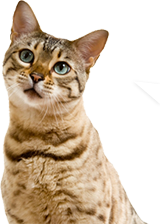Loose Leash Walking
 Walking your dog should be a fun and relaxing way for both of you to enjoy the outdoors and get a little exercise. If your dog is constantly pulling, walking can be more of an uncomfortable chore and you are less likely to want to do it. When we are teaching our dogs how to walk on a loose leash, we do not mean that the dog will remain in the strict “heel” position used in obedience training, but rather that they will keep slack in the leash at all times, even when sniffing and exploring.
Walking your dog should be a fun and relaxing way for both of you to enjoy the outdoors and get a little exercise. If your dog is constantly pulling, walking can be more of an uncomfortable chore and you are less likely to want to do it. When we are teaching our dogs how to walk on a loose leash, we do not mean that the dog will remain in the strict “heel” position used in obedience training, but rather that they will keep slack in the leash at all times, even when sniffing and exploring.
It is important to let your dog smell the environment when out on a walk. Sniffing and interpreting the information is a mental workout for your dog, and they can benefit more from walks where they get to use their nose versus longer distance walks without being allowed time to sniff. Free time to sniff can be a great reward for walking with you on a loose leash.
Before you begin training for loose leash walking, be prepared with the following:
- You will need a properly fitting collar and/or harness and leash. No retractable leashes! Retractable leashes always keep tension on the lead unless locked into position.
- You will need to be patient. Loose leash walking is more difficult than teaching a cue such as “sit” or “down,” and your dog is not likely to learn it overnight.
- Until your dog has mastered walking without pulling, every walk is a training session. Sessions should be kept short and fun for your dog.
- You will need to provide another outlet to exercise your dog, such as playing fetch, tug, or a play date with another dog. Ideally, exercise your dog before loose leash walking training sessions.
- You will need plenty of high value treats. Many dogs like cheese, hot dogs, or chicken. These should be cut up into pea-sized pieces, so your dog does not consume too much during sessions.
- Keep in mind that walking is great exercise for humans, but a few laps around the block is not enough exercise for the average dog. You will need to provide your dog with plenty of exercise and enrichment, especially if they are a young or very active dog.
Let’s Get Started!
The Red Light, Green Light Method
Dogs pull because it is reinforcing. If your dog wants to sniff that mailbox, they will pull you over to it as fast as they can and be rewarded for their efforts when they arrive at the delightful smelling mailbox. You must teach the dog that that pulling does not get the result they want. Instead, pulling will now result in bringing the walk to a stop, and keeping slack in the leash will result in the walk continuing.
For your first few sessions, you may want to work in your home or yard where there are limited distractions for your dog. Clip the leash to your dog’s collar and begin walking. The instant your dog reaches the end of the leash and pulls – red light! Stop immediately and wait. When your dog stops pulling and puts slack in the leash, pleasantly say “yes” or “good” and begin walking again – green light! In this case, being able to move forward is the reward to your dog. If you find yourself stuck with your dog continuing to pull, you can turn around and head the other direction to help your dog put slack in the leash.
Remember to be patient and consistent, and to never move forward when there is tension on the leash. It may be helpful at first to measure your training walks in minutes, not distance traveled!
The Lure and Treat Method
If your dog is struggling with Red Light, Green Light, or if they are very treat-motivated, adding treats to your training regimen can be extremely helpful. Fill your treat pouch or pocket with high value treats and start with your dog on whichever side of you is more comfortable (we will use the left side for this example). Remember to start off in a low-distraction environment, like in your home, before advancing to more distracting, outside environments. Hold the leash in your right hand and be ready to treat with your left hand. At first, hold the treat right in front of your dog’s mouth, then take one step, stop, and give them the treat. Repeat a few more times and then, when your dog begins to eagerly look up at you for more treats, take a few steps and then treat. Slowly add steps in between treats and, over time, you will be able to walk comfortably with your dog close to you and on a loose leash. Remember, loose leash walking will take a lot of time, effort, and consistency! You should continue bring treats on walks to periodically reward your dog.
Remember to never let your dog get to the end of the leash. You can prevent that from happening by offering a treat sooner rather than when it is too late. Reward your dog with a treat when they check in with you and automatically return to your side. Continue the principles of Red Light, Green Light and never move forward when there is tension on the leash.
Exploring on a Longer Lead
It is highly recommended that you allow your dog to investigate the environment with their nose. You can teach your dog to walk and explore on a longer leash using the same principles you learned from Red Light, Green Light and by rewarding your dog with treats. You can use a longer leash than you normally walk with or you can purchase a long-line (most long lines vary between 20 and 50 feet). Encourage your dog to check in with you by saying their name in a cheerful tone and treating them when they return to your side.
Helpful Gear Recommended by the Wisconsin Humane Society
If your dog has had years of being reinforced for pulling while walking on leash, or if your dog is very strong, you may need some extra support from specialized equipment. There are a lot of items on the market and the choices can be overwhelming. Always remember to purchase comfortable and well-fitting equipment. Avoid an item that will cause pain to your dog, such as a choke chain or prong collar. These are considered aversive and potentially damaging, and of course, we do not want to hurt our dogs.
Front Clip Harnesses can help you manage a strong-pulling dog while you work to improve their loose leash walking skills. Harnesses can also prevent potential harm from excessive pressure on a dog’s trachea if they do pull. The leash connection ring is normally located on the center of the chest strap so that when the dog pulls, their front end may slightly turn back towards the handler. This results in slack in the leash and gives you a window of opportunity to reinforce and reward the slacked leash. It is important to find a non-restrictive, front clip harness that does not cross your dogs’ shoulders in a way that it restricts their movement. It is also important to find a harness that is secure and does not put your dog at risk of being able to easily slip out of the harness. A few of the harnesses we recommend are the Balance Harness, Ruffwear’s Front Range Harness, and the Perfect Fit Harness.
*Be sure your dog is always wearing a collar while wearing a harness for identification purposes. Harnesses should also only be worn for walking purposes and should not be left on in the home or during play.
Visit Whole Dog Journal for a list of top-rated front clip harnesses.
Other recommended equipment:
The Weiss Walkie is a great tool for dog guardians and animal shelters that want an easy, one-size-fits-all way to reduce pulling comfortably and humanely.
The Gentle Leader® Headcollar is designed to encourage the dog to stop pulling and can assist with other behavior challenges. Unlike most harnesses, this headcollar cannot be placed on the dog for immediate use. The dog must have time to get accustomed to how it feels before beginning training. We recommend working with a professional, force-free, positive reinforcement trainer if you choose this tool.
The Martingale collar is a flat, nylon collar that has a short, n—slip loop. This helps prevent dogs from slipping out of their collar and, when fitted properly, will be snug without constricting the airway.
Loose Leash Walking is a skill that takes time, patience, and consistency. If you find your dog is having a difficult time with this exercise, the environment may be too distracting. You can go to a quieter area, increase the value of your treats, or try a different collar.
Please check out the Wisconsin Humane Society’s online store at shop.wihumane.org to purchase products or to find out more information.
WHS also offers routine courses to support your training goals with your companion. Learn more and register for a start date by visiting our calendar of events at wihumane.org/events-calendar.
